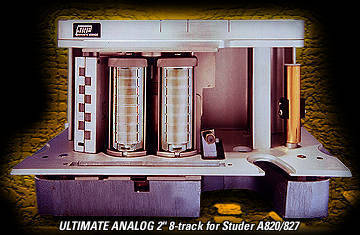Robertobly
New member
Hello,
I know these are quite possibly hard questions to answer & perhaps a little 'open ended'. However any help would be greatly appreciated & help a young band of brothers onto the next step of recording their music
1. Q when does bouncing have a noticeable effect on the quality (ie if you are using a 4 track 1/4" reel to reel machine when does it stop being the quality u get from just those 4 tracks used with no bouncing)
2. Q is 1" 8 track running at 30ips same as 2" 16 track running at 15ips. (same inch per track)...
we know tape speed changes req response independent of width (ie 30 ips is 'brighter' & 15 ips is less top end & better for lower freqs). does reducing tape width reduce fidelity independent of speed.
3. Q 2 diff mastering scenarios -
A straight out of reel to reel via an a/d into a DAW (then rendering a WAV)
B through a mixer into 2 (stero) track 1/2" or 1/4" tape - then digitizing from the master tape or vinyl made from the master.
what are the implications of these different set ups with regard to the end sound. is it going to be hard to tell the difference or are there any big differences going on?
4. big diff? whats the diff? between 2" 8 track (1/4" per track) & 2" 16 track (1/8" per track) - both runnin same speed (15 or 30 ips)
Regards & thanks in advance for any help you can give,
Rob
I know these are quite possibly hard questions to answer & perhaps a little 'open ended'. However any help would be greatly appreciated & help a young band of brothers onto the next step of recording their music

1. Q when does bouncing have a noticeable effect on the quality (ie if you are using a 4 track 1/4" reel to reel machine when does it stop being the quality u get from just those 4 tracks used with no bouncing)
2. Q is 1" 8 track running at 30ips same as 2" 16 track running at 15ips. (same inch per track)...
we know tape speed changes req response independent of width (ie 30 ips is 'brighter' & 15 ips is less top end & better for lower freqs). does reducing tape width reduce fidelity independent of speed.
3. Q 2 diff mastering scenarios -
A straight out of reel to reel via an a/d into a DAW (then rendering a WAV)
B through a mixer into 2 (stero) track 1/2" or 1/4" tape - then digitizing from the master tape or vinyl made from the master.
what are the implications of these different set ups with regard to the end sound. is it going to be hard to tell the difference or are there any big differences going on?
4. big diff? whats the diff? between 2" 8 track (1/4" per track) & 2" 16 track (1/8" per track) - both runnin same speed (15 or 30 ips)
Regards & thanks in advance for any help you can give,
Rob
Last edited:



